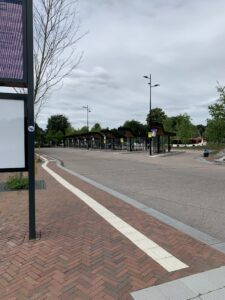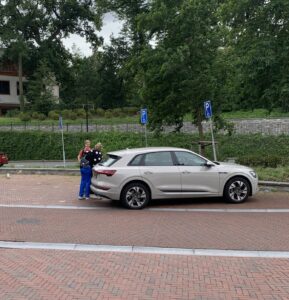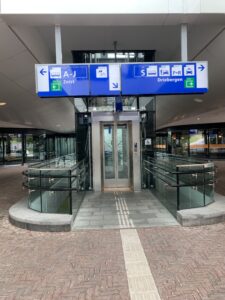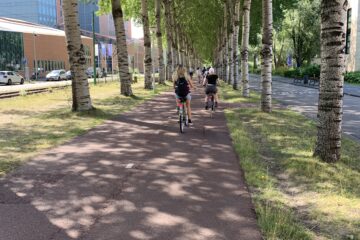
This photo shows the bus bays oriented to the stairs so you walk up the stairs and can see the bus displays on the fronts of the buses.
Driebergen-Zeist Mobility Hub
Today we took buses, bikes and trains to go visit the new mobility hub that opened at the Driebergen-Zeist train station. These two small towns are located just outside of Utrecht. The total distance is just under 7 miles between Copenhagen Centraal Train Station and the Driebergen-Zeist Train Station. This link here has some images of its recent re-construction.
There were two different shops located at the mobility hub. One was a small convenient store and the other a cafe.
The bus arrived first! Buses get a queue jump at traffic signals – the bus slips into the right turn lane and gets an early green to go straight (similar to a leading pedestrian interval where peds get an early walk signal; it is triggered by a system similar to opticom detection for a fire truck), so the bus rarely gets stopped at red lights and can quickly go straight through the intersection.
- Data for trips between Utrecht and Driebergen-Zeist
- 6.8 miles
- 5-minute bus headways (3-minute prior to covid)
- 23 to 28 minute bus trip time (express or local bus)
- 12- & 8-minute (12 min, followed by 8 min, followed by 12 min) train headways.
- Every other train is an express and local (stopping at every station).
- 10 minutes train trip time (give or take a few (local or express)).
- 300 car parking stalls
- 3,000 bike parking stalls (underground)
- drop off zone and taxi wait
- ov-fiets bike share bikes (free with annual train pass)
The bike parking lot is managed, so bike theft is prevented – there is staff member there all the time.
The service is about the same Monday to Friday as it is Saturday and Sunday. There really is not any loss of service level (headways still short). And the transit service (train and bus) start running at 6:00 AM and stop running just about mid-night.
The population of Zeist is about 65,000 people. About 2x as large as Redmond, Oregon. Driebergen is about 20,000.
The re-design added a nice bus station – buses were routed into the loop to the bays to have each bus facing folks as they exit the train station. This way people can easily see the bus’s front reader boards so it is easy to identify your bus.
There is now a dedicated walk/bike underpass built under the station to create good community connectivity and safely cross the railroad tracks.

Kiss and ride drop off zone!
How is there such great service for Transit Here?
How do these small towns commit to such great transit service – 5-minute headways? For a town of 65,000?
The transit service providers are private companies – and they must compete against each other to get service areas. Competition is fierce. We met with Bradley Tollesen who works for TransDev (or Connections as it is locally called). The private firm must develop the routes, the schedules, purchase the buses, provide the bus maintenance (and bus recharging/fueling), hire bus drivers – basically everything.
The RFP’s that go out by the regional governments provide the criteria that must be met (broadly like this is the service area, and specifically like all buses must be zero emissions by 2025). Brad’s job is to develop the routes to serve the most people for the least cost. He scours the world looking for the best buses (those that work the longest with the least maintenance needs and mechanical issues); he creates the schedules, routes, and the headways to be competitive. His firm develops the fare schedules. He leases the bus barns and the mechanical garages. The private firms are incentivized to keep costs as low as possible while providing the best service. The firms are evaluated by their service record (number of passengers, boarding and alighting counts, on-time percentages, fare-box recovery rates, and ride costs, fleet emissions and fuel usage, etc.), and if they aren’t performing up to their contract, they can lose a concession. Which means that might have to lay off staff and sell buses. So they try really hard to keep on top of things.
It is so competitive that bids are highly protected and secret – trade secrets like scheduling software used, modeling, and re-fueling/re-charging strategies are kept under strict wraps so they can’t be stolen by competitors.

Photo of a ticket machine – owned by ns.nl rail company. The rail company is nationally run. The machine takes coins as well as credit and debit cards.
Some routes are recovering about 60% farebox costs, while more rural routes recover about 40%. How is the difference funded? The remaining costs are paid for via the concession contract with the local government.

New walk/bike tunnel under railtracks connects the community in a safe manner across the tracks.

There are comfortable stairs as well as elevators. The elevator fits a bike and opens forward so you don’t have to back out of the elevator.
Lessons for Central Oregon?
Probably most obvious is a lot of regional funding is provided to service providers for both transit and train service. Investments by regional governments (and national government) to build mobility hubs, train stations, and lay track are quite high. The ease of riding the bus or taking the train gains loyal riders. The short headways mean you don’t have to worry about missing a route. And the competition for service means routes are scheduled to maximize coordination between train and bus, to maximize ridership.
The other thing here is more employers fund their employee transit passes on an annual basis, so the employee gets a perk and doesn’t have to worry about commuting costs. The annual transit pass comes with a bike share bike (OV-Fiets Bikes).
The transit service allows the cities and counties to meet congestion goals and emissions goals to keep air clean and citizens happy.



2 Comments
David Green · July 11, 2022 at 4:22 am
It would be so luxurious to have a transit service like this!
Janet Hruby · July 12, 2022 at 9:27 pm
Wow – competitive private business for transit, not just rideshare. Seems like there still may be some cross-over ideas. Might be great to share with CET on your post trip reports!